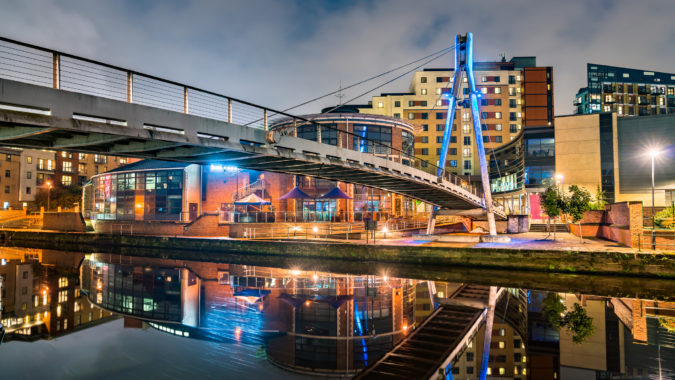Good morning.
Thank you to Transport Times for hosting today’s event, and for kindly inviting me to open the proceedings. Thank you also for giving my fellow Commissioner, Julia Prescot, and staff from the Commission the opportunity to talk more this afternoon about our vision for the UK’s future transport infrastructure.
The National Infrastructure Commission is now in its third year and this is our most important year to date.
In a few weeks’ time, we will be publishing the UK’s first-ever National Infrastructure Assessment. It will be truly ground-breaking, offering an analysis of the UK’s long-term needs, assessing national policy and looking across several key sectors.
You may recall that last October we published Congestion, Capacity, Carbon, which set out our vision and priorities for UK infrastructure in the years ahead. Our then Chairman, Lord Adonis described it as, “a milestone in the process”. But he was also clear on our overall mission: to “inject vision and purpose into how we plan, fund, deliver and operate the networks which underpin our economy and society.”
Our forthcoming final Assessment therefore spans the next 30 years, setting out how the needs we have identified, across energy, water and sewerage, flood risk, digital communications, waste and of course transport, should be met.
In addition, the Commission has also highlighted 12 major priorities where urgent action is required to support key infrastructure programmes. In each case, there is a commitment in principle from Government – but with some of these there is still a real risk that without timely decisions these projects could stall or collapse entirely.
Of the 12 priorities identified, five are transport focussed – underlining the vital role that road, rail and air travel plays in supporting economic growth across all parts of the country.
I am pleased to say that good progress is being made on many of these priorities – including the recent announcement that the Silvertown tunnel is to go ahead.
It’s seven months later than we originally wanted – but nevertheless it is good to see this project moving from planning to digging.
HS2 remains on track – if you’ll pardon the very bad pun – and progress is being made by Transport for the North and others on developing a Strategic Transport Plan. More immediately, it will be important that Government sticks to the agreed timetable for upgrading the Trans-Pennine Route and reaches agreement, ideally before the end of this year, on a timetable and funding envelope for the Northern Powerhouse Rail network. This has the potential to transform connectivity between the major economic centres of the North of England.
Turning from the North of the country to the South, we want Government to ensure that the independent review of the funding and financing of Crossrail 2 is completed as soon as possible, with a view to setting out a firm timetable and funding proposal by the end of this year. The next stage of consultation should then follow to enable the introduction of a hybrid Bill later this Parliament, with the overall aim of opening Crossrail 2 in the early to mid-2030s.
Never has the need for direct connections to the growing economies of the world been more pressing than it is today.
But the delays over the last decade in the planning of new national airport capacity is one of the most obvious and often-quoted examples of the problems encountered with infrastructure decision making.
It has taken far too long to reach a decision on a third runway at Heathrow: it has been 13 years since a statement of state policy in favour of the expansion of the UK’s principal hub airport, and three years since the Airports Commission reviewed the case in detail – we must make progress on this crucial project.
Heathrow plays a unique role in the UK’s richly diverse airports sector – the only airport in the country with the sheer demand, not only from UK travellers but also from those transiting through on the dense and farreaching network of long-haul services.
Heathrow is also the most important freight airport in the UK, with a wellestablished logistics sector in the surrounding area which would benefit significantly from the new connectivity and capacity provided through expansion.
And as we look to develop and strengthen our trade relationships across the world, going ahead with the third runway sends a powerful message that the UK is open for business – not just for the benefit of London and the South East but for the country as a whole.
But expansion in the air alone is not the answer. At ground level, we need to ease congestion on our roads and embrace zero emission and driverless vehicles as well as adopting smart technology on the roads themselves.
If the recent report from the Commission on Travel Demand is anything to go by, I’m in the UK’s only age group in which car mileage per capita is growing.
Like many here today, I am of the baby-boomer generation with a lifetime of driving behind me….and by all accounts, the younger generations are far less car dependent and far more interested in travelling by other modes such as bike or train.
That said, we know there is increasing congestion on all parts of the transport network and that is something we need to tackle.
It’s rather apposite therefore, that today I can announce the five finalists in our Roads For The Future Competition.
We know that the UK is among world-leaders in developing connected and autonomous vehicles, with the first such cars already being tested. But as the technology improves and progresses, the country’s road network will need to adapt to ensure the country can make the most of this opportunity.
In conjunction with Highways England and Innovate UK, we launched this competition to find the best ideas to address issues such as road design, traffic management and how the rules of the road may need to be adapted to take account of new technology.
In essence: how can we change the UK’s roads to maximise the benefits of connected and autonomous vehicles?
More than 80 individuals and companies rose to that challenge and the five chosen by the judging panel to go forward to the final will be revealed shortly.
We can see for ourselves the progress in developing cars for the future, with trials of driverless vehicles taking place across the country.
In 30 years’ time, road transport will, without doubt, be very different. For example, we expect many vehicles to run on electricity, making our air cleaner and our roads quieter.
Currently vehicles contribute to 80% of air pollution breaches and more than a quarter of greenhouse gas emissions.
We need to change that through greater use of alternative-fuelled, electric and autonomous vehicles. Managing demand with smart chargers could save 8 billion pounds in electricity network upgrades by 2050.
We must also be prepared to be radical in our thinking to generate new ways of doing things. Our ambition should be for driverless public transport rather than purely for driverless private use cars and vans. When done well, people are more willing to get out of their cars and make greater use of public transport – crucial given that this is a key part of the solution to easing congestion.
This should be a consideration as part of wider efforts to make our roads smarter, more flexible and ready for connected and driverless vehicles.
People will drive the cars of the future only if they are affordable and they are confident that there is a charging infrastructure in place to make their use convenient and stress free.
And that leads me to the announcement about our five finalists in the Roads For the Future Competition. The creativity and ingenuity of the entries was very impressive. Many made the most of our existing network to prepare for innovation, which by 2050, will seem commonplace.
The five finalists – hailing from Yorkshire, Devon, Oxfordshire and London included smart traffic light systems, flexible use of kerbsides, driverless zones, and sat-navs using artificial intelligence technology in their bids to design roads fit for driverless cars.
AECOM want to examine how smart signals could alert drivers and vehicles to the speed they should drive at, so they arrive at the next set of traffic lights just as they turn green. This, they say, will help to cut congestion and end ‘stop-go’ driving. The concept will be tested using a simulation model of the A59 in York.
Meanwhile, Arup are looking at how kerbsides with fixed features such as double yellow lines, parking bays and bus stops could become more flexible, their use changing according to the time of day and levels of demand to meet the most pressing needs.
City Science – based in Exeter – are focussing on how sections of existing roads could be dedicated to driverless cars and the implications for urban high streets and motorways, exploring how road designs and rules should be updated for both driverless cars and those with drivers.
Oxford will be the virtual testing ground for Immense’s ideas. They want to look at how the latest artificial intelligence could be used to help sat-nav systems to ‘learn’ better routes to improve the directions given, so that both driven and driverless cars could change course to avoid congestion.
And back to Yorkshire where a team from Leeds City Council will examine how the data generated from digitally connected cars could be used to improve traffic light systems, allowing highway authorities to better manage traffic on their roads and reduce tailbacks.
These five will receive 30,000 pounds to further develop these innovative ideas over the next three months. I look forward to seeing what they come up with – and undertaking the difficult task of working with my fellow jurors to pick an overall winner, who will receive a 50,000 pound prize.
We know that by 2050, our transport networks will look very different; how they will be different is less certain.
But a world where traffic lights turn green as we approach them, where our sat-navs can use artificial intelligence to avoid congestion, and where we can adapt simple street furniture like double yellow lines and bus stops to put our roads to the most efficient possible use, fills me with hope and a sense of anticipation.
Hope that our children and grandchildren will have safer, cleaner and more reliable travel experiences than we have today; they’ll be able to move from place to place with much less stress and much more ease and that in part, will be down to the work of bright minds such as these five finalists and the wider work of the National Infrastructure Commission.
We know that the technologies we are investigating today will become commonplace in a matter of years – so to have industry and academia respond so enthusiastically and creatively to our call for ideas for the Roads For the Future is encouraging and exciting. And to be doing this while at the same delivering this country’s first-ever National Infrastructure Assessment means we can start investing now to make the most of these innovations for the next three decades.
So this event by Transport Times offers the chance for lively discussions and debates over the course of the day – and I greatly look forward to hearing the ideas that you have for making the most of these opportunities for years to come.
Thank you.



